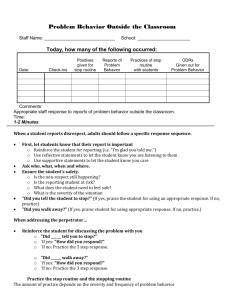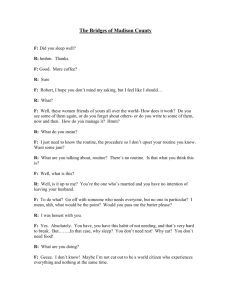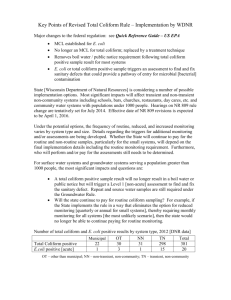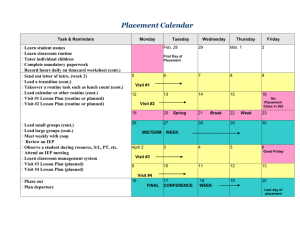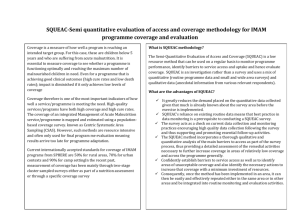Word Doc - Marion County
advertisement
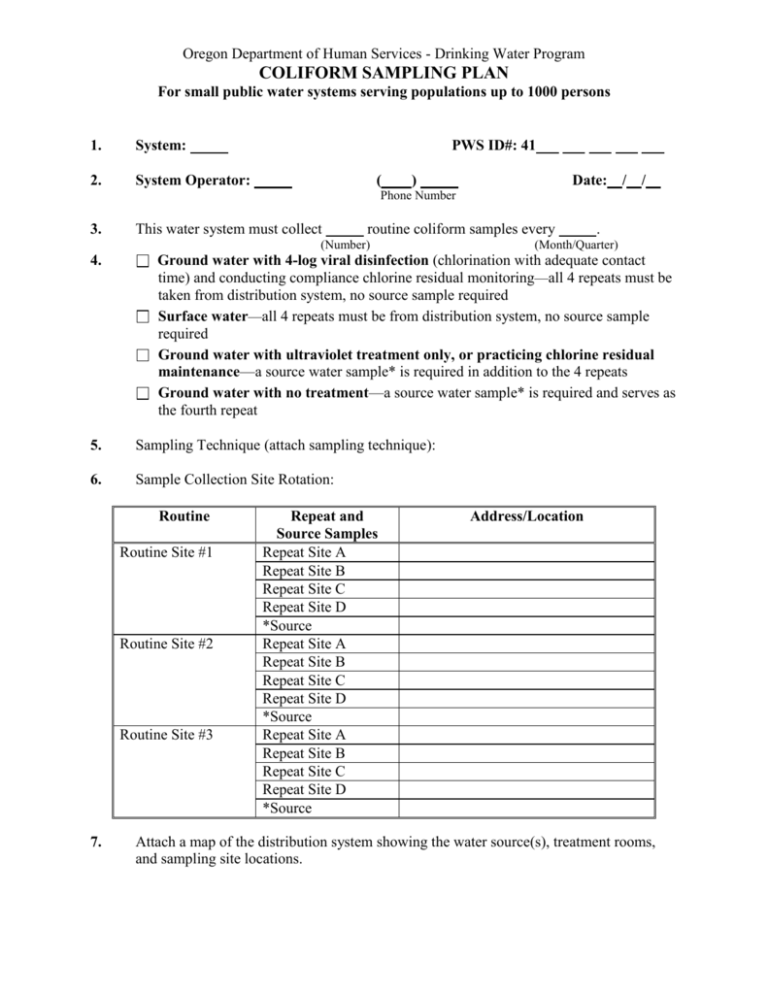
Oregon Department of Human Services - Drinking Water Program COLIFORM SAMPLING PLAN For small public water systems serving populations up to 1000 persons 1. System: 2. System Operator: PWS ID#: 41 ( ) Date: / / Phone Number 3. This water system must collect routine coliform samples every (Number) 4. Ground water with 4-log viral disinfection (chlorination with adequate contact time) and conducting compliance chlorine residual monitoring—all 4 repeats must be taken from distribution system, no source sample required Surface water—all 4 repeats must be from distribution system, no source sample required Ground water with ultraviolet treatment only, or practicing chlorine residual maintenance—a source water sample* is required in addition to the 4 repeats Ground water with no treatment—a source water sample* is required and serves as the fourth repeat 5. Sampling Technique (attach sampling technique): 6. Sample Collection Site Rotation: Routine Routine Site #1 Routine Site #2 Routine Site #3 7. . (Month/Quarter) Repeat and Source Samples Repeat Site A Repeat Site B Repeat Site C Repeat Site D *Source Repeat Site A Repeat Site B Repeat Site C Repeat Site D *Source Repeat Site A Repeat Site B Repeat Site C Repeat Site D *Source Address/Location Attach a map of the distribution system showing the water source(s), treatment rooms, and sampling site locations. COLIFORM SAMPLING PLAN For small public water systems serving population up to 1000 persons INSTRUCTIONS 1. Fill in the name and ID number of the water system. 2. Fill in the name of the contact person or system operator with their day-time phone number and the date the sampling plan was completed. If the contact person changes or sampling sites change, update the sampling plan. 3. Fill in the number of routine samples you are required to take and the required sampling frequency (monthly or quarterly). 4. Check the box that describes the water system. Follow the repeat sampling requirements that correspond to the type of water system described. 5. Insert the sampling instructions given to you by the laboratory you contract with to analyze the water samples. Example of proper coliform sampling technique: Using a non-swivel faucet, remove any aerator, screen, hose, or other attachment and flush for 35 minutes. Use only sample bottles provided by the lab specifically for bacteriological sampling. Don’t open the sample bottle until the moment of filling and don’t touch the inside or lid of the bottle. Reduce the water flow to a steady stream and gently fill the bottle, leaving an air space of at least ½ inch at the top. Replace the cap immediately. Label the sample bottle with all pertinent information including: system name and ID number; date, time and location of sample; name of person collecting the sample; sample type (‘routine’, ‘repeat’, ‘source water’, or ‘special’); and free chlorine residual if the system is chlorinated. 6. Pick three (3) routine coliform sample sites. Select routine sampling sites that together represent the entire distribution system during sampling. Rotate sample collection between these three (3) routine sites. Identify repeat and source sample sites for each routine site according to the outline below: Repeat Site A = Same as the routine sample site. Repeat Site B = A location within 5 service connections up from the routine site. Repeat Site C = A location within 5 service connections down from the routine site. Repeat Site D = Ground water with 4-log viral disinfection and conducting compliance chlorine residual monitoring -Take the fourth repeat anywhere in distribution system; no source sample required. Surface water - Take the fourth repeat anywhere in distribution system; no source sample required. Ground water with ultraviolet treatment only, or practicing chlorine residual maintenance - Take the fourth repeat from the distribution system, but also take a source sample in addition to the 4 repeats. Label the source sample type as ‘source water’ only. Ground water with no treatment - A source sample is required and serves as the fourth repeat. Label source sample type as both ‘repeat’ and ‘source water’. NOTE: Repeat samples are taken only if a routine sample result is coliform present. A water system is not in violation unless a repeat sample result is coliform present. Repeat samples must be collected within 24 hours of being notified of the results, unless the system has a single connection, then the system may be allowed by the DHS Drinking Water Program to collect the repeat samples over a four day period from laboratory notification. Systems with a coliform present routine sample must collect five routine samples the month following the routine present sample regardless of whether an MCL violation occurred or if repeat sampling was coliform absent. 7. Attach a map of the distribution showing the water source(s), treatment rooms, and sampling sites’ locations. Contact your local county Environmental Health Program office or the DHS Drinking Water Program at (971) 673-0405 with any questions about your coliform sampling plan.


